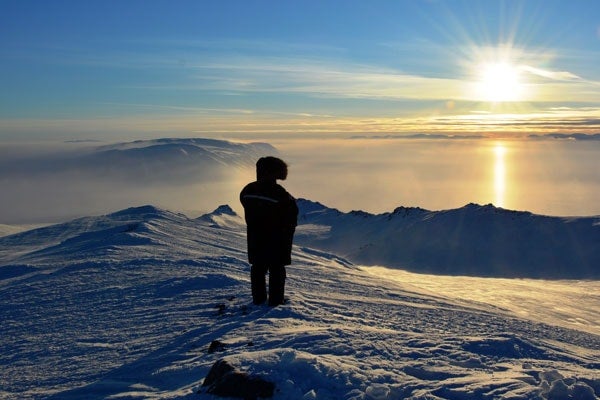
Reporting from the Arctic: when fog hits
Published: March 19, 2014
Dan Weaver is a graduate student at the University of Toronto whose research takes him to PEARL, the Polar Environment Atmospheric Research Laboratory on Ellesmere Island, near Eureka, Nunavut.
What kind of work takes a PhD candidate from U of T's physics department to an experimental lab at the northern edge of Canada? Start with climate, ozone depletion, atmospheric dynamics, and air quality. (Read more about Weaver's work up north.)
Weaver is scheduled to leave the Arctic soon but he filed this dispatch on March 18, 2014.
The PEARL Ridge Lab is situated 610 meters above sea-level. This isn’t as impressive as sitting atop a mountain, but it can give us an advantageous view. A few days ago, our altitude gifted us with a spectacular and unusual scene. An intense fog swept into and filled the fjord and low-lying areas below us. We were perfectly perched to watch
According to John MacIver, the Eureka Weather Station’s Station Program manager, a lead (large crack in the ice) likely opened in a nearby sound. The newly exposed water was nearly 50°C warmer than the Arctic atmosphere directly above it. The influx of humidity into the frigid Arctic air quickly formed fog. The Ridge Lab had a great view.
 The phenomenon didn’t just offer an interesting photo opportunity; it offered a useful scientific opportunity, too. The zero-altitude PEARL Auxiliary Laboratory (0PAL) is located a short walk from Eureka’s weather station. It complements the work done at the Ridge Lab by giving researchers the ability to study with lowest parts of the atmosphere (in addition to the rest). On this particular day, 0PAL was immersed in the fog, and was equipped to measure it.
The phenomenon didn’t just offer an interesting photo opportunity; it offered a useful scientific opportunity, too. The zero-altitude PEARL Auxiliary Laboratory (0PAL) is located a short walk from Eureka’s weather station. It complements the work done at the Ridge Lab by giving researchers the ability to study with lowest parts of the atmosphere (in addition to the rest). On this particular day, 0PAL was immersed in the fog, and was equipped to measure it.
One of the instruments at 0PAL is the CANDAC Rayleigh-Mie-Raman LIDAR (CRL) – a powerful laser that shoots straight up into the atmosphere. Some of the laser light is reflected back down towards the lab, where it is collected by a telescope and analyzed. The CRL laser light is polarized. If it interacts with spherical liquid droplets, the reflected light will remain polarized. If clouds are partially or fully made up of ice particles, the reflected light will be a mixture of polarization orientations. Researchers use measurements of different polarizations (parallel and perpendicular) to determine what clouds are made of. Having the ice fog directly above the instrument allowed CRL scientists to check its performance.
Emily McCullough, a Western University Ph.D student who helps run the lab, explained to me that, “With ice fog, it is as though an ice cloud is visiting the lab. It is a great reality check for our calibrations. "The measurements from that afternoon showed high signal counts in all polarization orientations. This event will help Emily and other CRL scientists interpret clouds they observe, and determine their properties.
The more we know about clouds, the more we know about the Arctic’s atmosphere and its climate.
Read the first instalment of the series
Read the second instalment of the series



